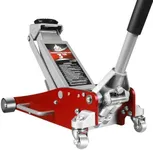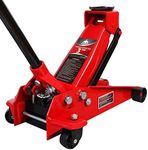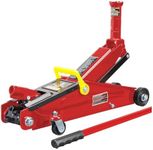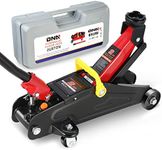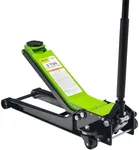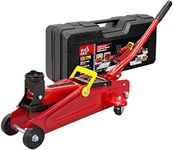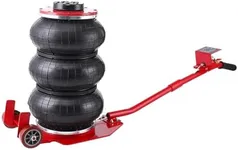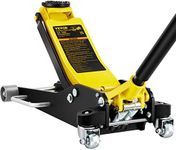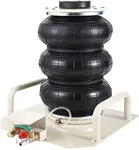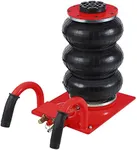Buying Guide for the Best Auto Floor Jacks
Choosing the right auto floor jack is crucial for safely and efficiently lifting your vehicle for maintenance or repairs. The right floor jack will depend on the type of vehicle you have, the weight of the vehicle, and the type of work you plan to do. Here are some key specifications to consider when selecting an auto floor jack, along with explanations to help you make an informed decision.Weight CapacityWeight capacity refers to the maximum weight the floor jack can safely lift. This is important because using a jack with insufficient capacity can be dangerous and cause damage to both the jack and the vehicle. Floor jacks typically range from 1.5 tons to 4 tons. For small cars, a 1.5 to 2-ton jack is usually sufficient. For larger vehicles like SUVs and trucks, a 3 to 4-ton jack is recommended. Choose a jack with a weight capacity that exceeds the weight of your vehicle to ensure safety.
Lift RangeThe lift range is the minimum and maximum height the jack can lift your vehicle. This is important because it determines whether the jack can reach the lifting points of your vehicle and provide enough clearance for you to work underneath. Floor jacks typically have a lift range of 3 to 20 inches. For low-profile vehicles, look for a jack with a low minimum height. For vehicles with higher ground clearance, ensure the maximum lift height is sufficient for your needs. Consider the type of maintenance you plan to perform and choose a lift range that accommodates it.
MaterialFloor jacks are commonly made from steel or aluminum. The material affects the jack's weight, durability, and portability. Steel jacks are generally more durable and can handle heavier loads, but they are also heavier and less portable. Aluminum jacks are lighter and easier to maneuver, making them a good choice for frequent use or for carrying in your vehicle. However, they may not be as durable as steel jacks. Choose a material based on your need for portability versus durability.
Saddle SizeThe saddle is the part of the jack that makes contact with the vehicle. Saddle size is important because a larger saddle provides better stability and reduces the risk of damage to the vehicle. Floor jacks come with different saddle sizes, typically ranging from 3 to 6 inches in diameter. For larger vehicles or when lifting at less stable points, a larger saddle is preferable. For smaller vehicles or precise lifting points, a smaller saddle may be sufficient. Consider the size and shape of your vehicle's lifting points when choosing a saddle size.
Pump MechanismThe pump mechanism determines how the jack is operated and how quickly it can lift the vehicle. There are single-pump and dual-pump mechanisms. Single-pump jacks require more effort and time to lift the vehicle, while dual-pump jacks can lift the vehicle more quickly and with less effort. If you need to lift your vehicle frequently or want to save time, a dual-pump mechanism is a better choice. For occasional use, a single-pump mechanism may be sufficient.
PortabilityPortability refers to how easy it is to move and store the floor jack. This is important if you need to transport the jack or have limited storage space. Factors affecting portability include the jack's weight, size, and whether it has wheels or a carrying handle. Lighter, more compact jacks with wheels or handles are easier to move and store. If you plan to use the jack in different locations or need to store it in a small space, consider a more portable option.
